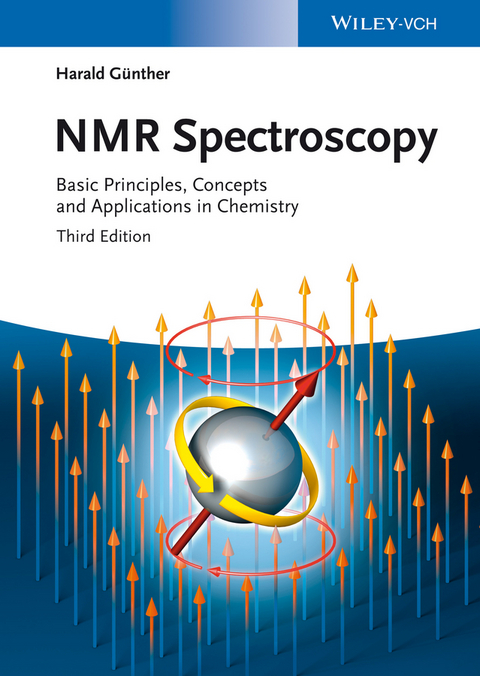NMR Spectroscopy
Wiley-VCH (Verlag)
978-3-527-33004-1 (ISBN)
Nuclear magnetic resonance (NMR) spectroscopy is one of the most powerful and widely used techniques in chemical research for investigating structures and dynamics of molecules. Advanced methods can even be utilized for structure determinations of biopolymers, for example proteins or nucleic acids. NMR is also used in medicine for magnetic resonance imaging (MRI). The method is based on spectral lines of different atomic nuclei that are excited when a strong magnetic field and a radiofrequency transmitter are applied. The method is very sensitive to the features of molecular structure because also the neighboring atoms influence the signals from individual nuclei and this isimportant for determining the 3D-structure of molecules.This new edition of the popular classic has a clear style and a highly practical, mostly non-mathematical approach. Many examples are taken from organic and organometallic chemistry, making this book an invaluable guide to undergraduate and graduate students of organic chemistry, biochemistry, spectroscopy or physical chemistry, and to researchers using this well-established and extremely important technique. Problems and solutions are included.
Harald Günther studied Chemistry at the Universities of Stuttgart and Heidelberg, Germany, followed by a Postdoctoral Fellowship at Mellon Institute, Pittsburgh, USA. He then became an assistant at the Institute of Organic Chemistry at the University of Cologne, Germany, where he also completed his habilitation. He became Professor of Organic Chemistry at the University of Cologne in 1970, and at the University of Siegen, Germany, in 1978.
PREFACE
INTRODUCTION
Literature
Units and Constants
PART I: Basic Principles and Applications
THE PHYSICAL BASIS OF THE NUCLEAR MAGNETIC RESONANCE EXPERIMENT
The Quantum Mechanical Model for the Isolated Proton
Classical Description of the NMR Experiment
Experimental Verification of Quantized Angular Momentum and of the Resonance Equation
The NMR Experiment on Compact Matter and the Principle of the NMR Spectrometer
Magnetic Properties of Nuclei beyond the Proton
THE PROTON MAGNETIC RESONANCE SPECTRA OF ORGANIC MOLECULES - CHEMICAL SHIFT AND SPIN - SPIN COUPLING
The Chemical Shift
Spin - Spin Coupling
GENERAL EXPERIMENTAL ASPECTS OF NUCLEAR MAGNETIC RESONANCE SPECTROSCOPY
Sample Preparation and Sample Tubes
Internal and External Standards; Solvent Effects
Tuning the Spectrometer
Increasing the Sensitivity
Measurement of Spectra at Different Temperatures
PROTON CHEMICAL SHIFTS AND SPIN - SPIN COUPLING CONSTANTS AS FUNCTIONS OF STRUCTURE
Origin of Proton Chemical Shifts
Proton - Proton Spin - Spin Coupling and Chemical Structure
THE ANALYSIS OF HIGH-RESOLUTION NUCLEAR MAGNETIC RESONANCE SPECTRA
Notation for Spin Systems
Quantum Mechanical Formalism
The Hamilton Operator for High-Resolution Nuclear Magnetic Resonance Spectroscopy
Calculation of Individual Spin Systems
THE INFLUENCE OF MOLECULAR SYMMETRY AND CHIRALITY ON PROTON MAGNETIC RESONANCE SPECTRA
Spectral Types and Structural Isomerism
Influence of Chirality on the NMR Spectrum
Analysis of Degenerate Spin Systems by Means of 13C Satellites and H/D Substitution
PART II: Advanced Methods and Applications
THE PHYSICAL BASIS OF THE NUCLEAR MAGNETIC RESONANCE EXPERIMENT.
The NMR Signal by Pulse Excitation
Relaxation Effects
Pulse Fourier-Transform (FT) NMR Spectroscopy
Experimental Aspects of Pulse Fourier-Transform Spectroscopy
Double Resonance Experiments
TWO-DIMENSIONAL NUCLEAR MAGNETIC RESONANCE SPECTROSCOPY
Principles of Two-Dimensional NMR Spectroscopy
The Spin Echo Experiment in Modern NMR Spectroscopy
Homonuclear Two-Dimensional Spin Echo Spectroscopy: Separation of the Parameters J and d for Proton NMR Spectra
The COSY Experiment - Two-Dimensional 1H,1H Shift Correlations
The Product Operator Formalism
Phase Cycles
Gradient Enhanced Spectroscopy
Universal Building Blocks for Pulse Sequences
Homonuclear Shift Correlation by Double Quantum Selection of AX Systems - the 2D-INADEQUATE Experiment
Single-Scan 2D NMR
MORE 1D AND 2D NMR EXPERIMENTS: THE NUCLEAR OVERHAUSER EFFECT - POLARIZATION TRANSFER - SPIN LOCK EXPERIMENTS - 3D NMR
The Overhauser Effect
Polarization Transfer Experiments
Rotating Frame Experiments
Multidimensional NMR Experiments
CARBON-13 NUCLEAR MAGNETIC RESONANCE SPECTROSCOPY
Historical Development and the Most Important Areas of Application
Experimental Aspects of Carbon-13 Nuclear Magnetic Resonance Spectroscopy
Carbon-13 Chemical Shifts
Carbon-13 Spin - Spin Coupling Constants
Carbon-13 Spin - Lattice Relaxation Rates
SELECTED HETERONUCLEI
Semimetals and Non-metals with the Exception of Hydrogen and Carbon
Main Group Metals
Transition Metals
INFLUENCE OF DYNAMIC EFFECTS ON NUCLEAR MAGNETIC RESONANCE SPECTRA
Exchange of Protons between Positions with Different Larmor Frequencies
Internal Dynamics of Organic Molecules
Intermolecular Exchange Processes
Line Broadening by Fast Relaxing Neighboring Nuclei
NUCLEAR MAGNETIC RESONANCE OF PARTIALLY ORIENTED MOLECULES AND SOLID STATE NMR
Nuclear Magnetic Resonance of Partially Oriented Molecules
High-Resolution Solid State Nuclear Magnetic Resonance Spectroscopy
SELECTED TOPICS OF NUCLEAR MAGNETIC RESONANCE SPECTROSCOPY
Isotope Effects in Nuclear Magnetic Resonance
Nuclear Magnetic Resonance Spectroscopy of Paramagnetic Materials
Chemically Induced Dynamic Nuclear Polarization (CIDNP)
Diffusion-Controlled Nuclear Magnetic Resonance Spectroscopy - DOSY
Unconventional Methods for Sensitivity Enhancement - Hyperpolarization
Nuclear Magnetic Resonance in Biochemistry and Medicine
INDEX
"Few good textbooks on NMR Spectroscopy are available at either the undergraduate or graduate levels. For those who want to go beyond elementary organic chemistry but without delving into all the mathematics Friebolin's book is probably the best among this category." ( Journal of Chemical Education , 5 June 2014)
| Erscheint lt. Verlag | 25.9.2013 |
|---|---|
| Sprache | englisch |
| Maße | 170 x 240 mm |
| Gewicht | 860 g |
| Themenwelt | Naturwissenschaften ► Chemie ► Analytische Chemie |
| Schlagworte | Biochemie u. Chemische Biologie • Biochemistry (Chemical Biology) • Chemie • Chemistry • Kernresonanzspektroskopie • materials characterization • Materials Science • Materialwissenschaften • NMR Spectroscopy / MRI / Imaging • NMR-Spektroskopie • NMR-Spektroskopie / MRT / Bildgebende Verfahren • Organic Chemistry • Organische Chemie • Pharmaceutical & Medicinal Chemistry • Pharmaceutical & Medicinal Chemistry • Pharmazeutische u. Medizinische Chemie • Spektroskopie • Werkstoffprüfung |
| ISBN-10 | 3-527-33004-6 / 3527330046 |
| ISBN-13 | 978-3-527-33004-1 / 9783527330041 |
| Zustand | Neuware |
| Informationen gemäß Produktsicherheitsverordnung (GPSR) | |
| Haben Sie eine Frage zum Produkt? |
aus dem Bereich




